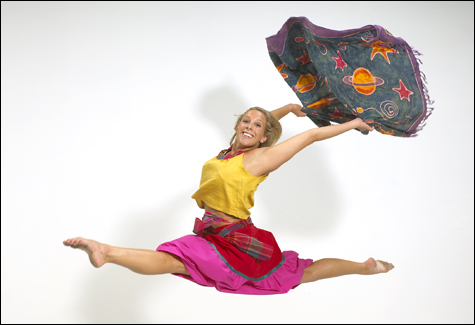
MORNING GLORY: DiIuro Swiatocha.
|
Fusionworks kicks off their 21st season with a show titled Different Directions that features the work of two New York-based choreographers — Chris Elam and Andrea Woods — as well as dances by artistic director Deb Meunier. Performances are November 16 and 17 at Sapinsley Hall at Rhode Island College, with behind-the-scenes explanations for the “unwrapped” show on Saturday.
Seen in a run-through two weeks ago, the five pieces definitely go in various directions, from brooding to boisterous, from meditative to menacing. The Woods piece, Morning Song, is set to an original score by Phillip Hamilton. It begins with five dancers (Stephanie Stanford Shaw, Shauna Edson, Karen DiIuro Swiatocha, Anne Gehman, and Melody Gamba) in various poses on the floor, as if looking at sand slipping through their fingers, examining a particular stone, or patting the ground reassuringly. This dance incorporates mesmerizing undulations of the neck, arms, hips, and shoulders, and a rippling of the fingers on each hand.
When the music kicks into an Afro-Cuban beat, each dancer (joined by Amy Bardenhegen) does a variation of shimmying and shifting shoulders from side to side, in a mix of modern dance and Caribbean moves. The most upbeat, uptempo moment comes with a strutting duet downstage and a back-up merengue quartet upstage. This piece ranges from tranquil to pull-out-the-stops party-time.
Next was Center, a solo Meunier made for long-time company member Stanford Shaw, set to music by the Bad Plus.
“Stephanie’s one of the more grounded people I’ve met as a dancer and as a friend,” Meunier explained, “and I wanted to explore, ‘How does one remain that way, when life is constantly throwing us off-center?’”
The lights come up on Stanford Shaw in a wide-legged plié, her fingers splayed on the floor, her weight on those fingertips and on her tiptoes in a frog-like crouch. She slowly unfolds her body into standing, with her hands coming together and moving overhead, but one foot goes in front of the other for stability. Later, in a difficult balancing pose, one leg is behind her in the air in a high attitude, bent at the knee. These slow, deliberate postures are contrasted to the dancer’s quick torso articulations to a piano arpeggio, then a large leap and a duck of the head as the vi¬cissitudes of life catch up to her and finally, a regaining of her “center.”
That stark emotional content contrasts sharply with the playful, animal-like movements of Elam’s Land Flat. Four dancers in fluffy feminine dresses waddle out, arms rounded in front of them, feet flat, walking like penguins. Their arms next form a “V” in which their faces are framed, and then the “V” is pointed down, like a beak, and the dancers prance on tiptoe.
Quiet moments are interspersed with fast twirls or manic bourées (sliding quickly on tiptoe). Sometimes there is a frantic whipping of the arms, a tapping of an extended toe, a scuttling crab pose, one dancer jumping up in a high-pitched squeal or two dancers jumping toward each other, touching chest to chest. This dance can be puzzling but also fascinating, as viewers speculate on the stories being told.
A piece from last year’s repertory (Meunier’s Twenty) has been renamed Rolling Rocks, in reference to the circular and almost-constant turning movements of its four dancers: rolling on the floor or arms windmilling or feet pinwheeling bodies into spins.
“The score [by Michael DeQuattro] and the dance are on the same plane, with the same manic physicality,” Meunier reflected. “DeQuattro was playing triplets off of five-counts. We wanted to push our envelopes.”
The last dance is Meunier’s “first ever political piece that grew out of the premise that I hate war and this war particularly and our place in this war.” Set to Nine Inch Nails’ “Survivalism” and titled Curve Ball, after the Iraqi informant, this duet (Gamba and Gehman) conveys the no-holds-barred “negotiations” between two white-shirted, black-panted characters who grab cloth dolls back and forth between them and sometimes march in military lockstep until one repeatedly yells “No!”
With new company members joining seasoned ones in these pieces, the Fusionworks troupe looks stronger than ever, with an emphasis on diversity and variety that has always defined their performances.